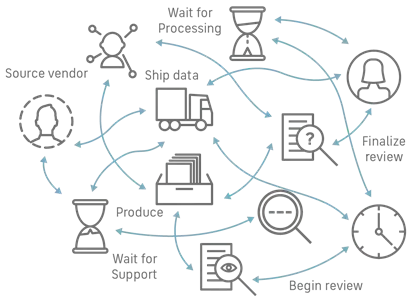eDiscovery is like the detective work of the legal world. Turning the mountain of ones and zeros of digital files into evidence in court. eDiscovery consists of identifying, collecting, processing, reviewing, and producing electronic documents and data in the context of legal proceedings.
______________________________________________________________________
In the beginning there was paper, and lots of it.
______________________________________________________________________
Discovery is the process by which parties to a legal dispute exchange relevant information and evidence relevant to the case. It can involve a wide range of activities, such as document requests, depositions, eDiscovery requests, and interrogatories. eDiscovery refers to the discovery process for Electronically Stored Information (ESI).
The goal of eDiscovery is to ensure that all parties have access to the relevant information and digital evidence necessary for the legal process. Think of it like a digital treasure hunt. But instead of gold doubloons, you are searching for emails, spreadsheets, and other electronic files.

What Happens During eDiscovery
If you’ve stumbled upon this excellent website (ACEDS) and are diving into this blog, chances are you’ve come across the EDRM model and the key phases of the eDiscovery lifecycle. But if you’re still scratching your head, fear not! I am going to to break it down for you:
What are the steps to eDiscovery?
- Identification – Start by finding whose data you want to explore and where it lives.
- Preservation – Ensure that the data remains intact and untouched, preventing any alterations or destruction (aka spoliation).
- Collection – Bring in the experts armed with the latest technology to make copies of the data itself, along with all the important metadata.
- Processing – Convert those mysterious 1s and 0s into a format that can be easily reviewed and get rid of any unnecessary clutter.
- Review – Gather a team of humans and tech wizards to carefully examine and categorize the data based on its relevance and potential issues, leaving behind the unnecessary baggage.
- Analysis – Utilize the insights gained from the review process to build a compelling case.
- Production – Share valuable, responsive data with the interested parties involved in the matter.

Now sometimes this process is far from this smoothly laid out. This as par for the course! Don’t worry if your eDiscovery journey doesn’t neatly follow this well-defined path. In the real world, things can get a bit messy. You might encounter unexpected twists and turns that require you to backtrack, repeat steps, or even start over. It’s all part of the adventure! Just remember to keep meticulous documentation throughout your expedition and equip yourself with adaptable technology that can navigate the ever-changing waters of eDiscovery.

Let’s Get Digital
Discovery as it was known before the “e” was added operated solely in the realm of paper. It consisted of bankers’ boxes, more papercuts than one should ever have imagined. And a very manual approach to uncovering information.
In today’s digital age, we leave a digital footprint with everything we do. From sending emails to creating spreadsheets, our electronic documents and data provide critical evidence in legal cases. The eDiscovery process is all about mining digital evidence for relevant ESI.
Some Electronically Stored Information (ESI) Includes:
- Email (Outlook, Gmail)
- Documents (Word, Excel, PowerPoint)
- Text messages
- Social Media (LinkedIn, Facebook, Twitter)
- Chat Applications and Instant Messaging Apps (WhatsApp, Messenger)
- Ephemeral Messaging tools (Signal, Telegram Wickr)
- Collaboration tools
Using sophisticated software and tools, legal teams can sift through this mountain of data. Uncovering the evidence needed to build their case.
Interested in ACEDS’s educational content? Subscribe to the ACEDS Blog for weekly blog updates: https://aceds.org/aceds-blog/



